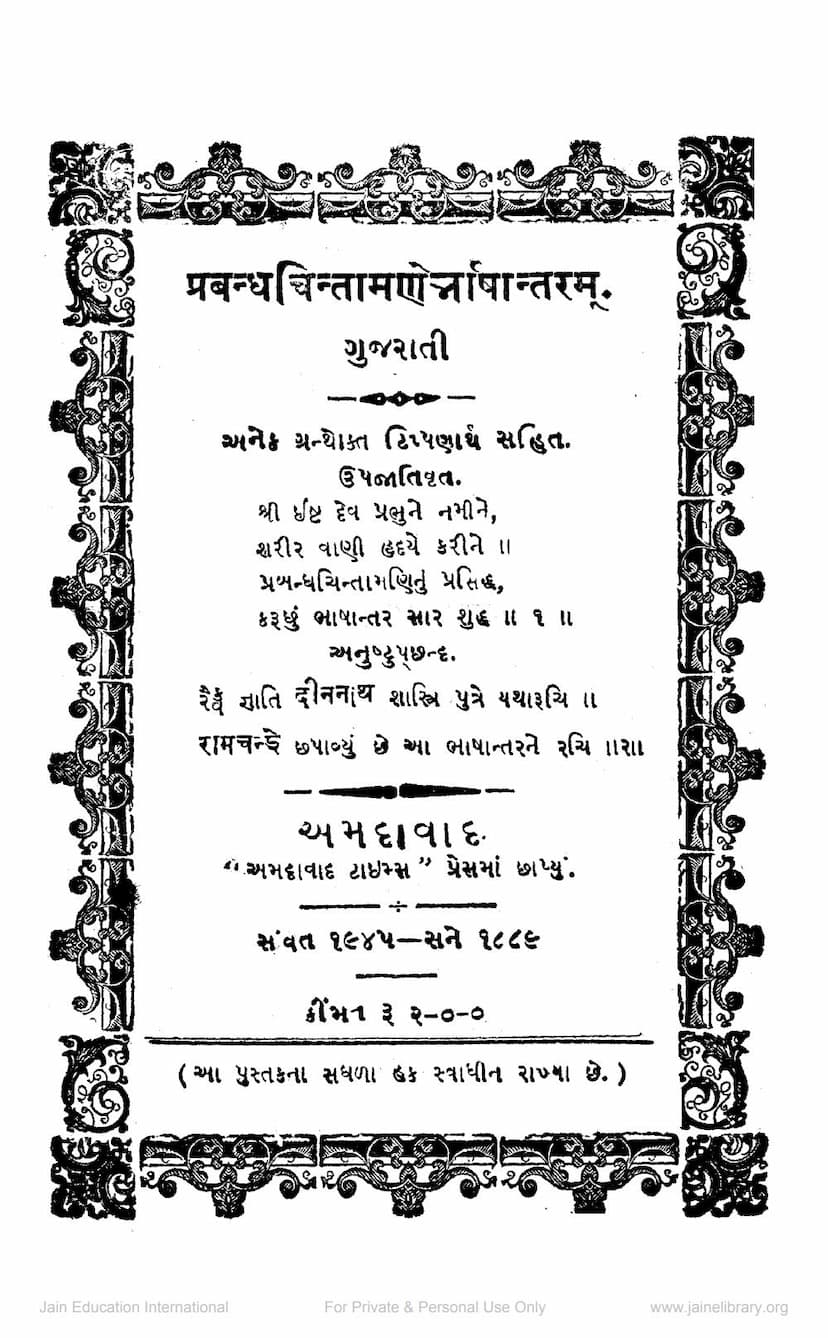Prabandh Chintamani
Added to library: September 2, 2025

Summary
This is a summary of the Prabandh Chintamani, a collection of historical narratives and anecdotes compiled by the Jain scholar Merutunga Suri (also known as Merutungacharya). The text, originally written in Sanskrit, focuses on the lives and deeds of prominent rulers, scholars, and religious figures, particularly from Gujarat and surrounding regions, spanning several centuries.
Here's a breakdown of the content based on the provided text:
Overall Nature of the Text:
- Title: Prabandh Chintamani (प्रबन्धचिन्तामणि)
- Author: Merutunga Suri (mentioned as "श्रीमेरुतुङ्गस्तद्द्यबन्धाद्ग्रन्थं तनोत्यमुम्" on page 37). The provided metadata lists "Ramchandra D Shastri" as author and publisher, indicating this is likely a later edition or commentary of the original Sanskrit work.
- Content: The book is a collection of prabandhas, which are narrative accounts or historical tales. It covers a wide range of topics, including the lives of kings, their interactions with scholars and religious figures, philosophical discussions, and events that shaped the political and cultural landscape of the time.
- Purpose: To preserve and disseminate knowledge about important historical figures and events, particularly those relevant to Jainism and the region.
Key Figures and Narratives Highlighted:
The bulk of the provided text, especially the detailed index starting from page 3, is an index of names and topics covered in the Prabandh Chintamani. This index allows us to see the vast scope of the work. Here are some of the prominent figures and themes evident from the index and the initial pages:
- Vikramarka (विक्रमार्क): A significant portion of the text is dedicated to the legends and stories surrounding King Vikramaditya of Ujjain. The narratives often highlight his wisdom, courage, justice, and patronage of arts and literature. Page 39 onwards begins the "Vikramarka Prabandha," detailing his interactions and exploits.
- Shalivahana (शालिवाहन): Another important ruler whose life and legends are narrated. The text mentions his association with the beginning of the Shalivahana era. Pages 59 onwards are dedicated to his stories.
- Bhoja (भोज): The illustrious Paramara king of Malwa, Bhoja, is also a central figure, with narratives focusing on his generosity, learning, and administrative skills. Pages 64 onwards delve into the "Bhoja Bhima Prabandha."
- Bhima (भीम): The text mentions King Bhima of the Chalukya dynasty, often in conjunction with King Bhoja, suggesting historical interactions or comparisons.
- Kumarapala (कुमारपाल): The Jain ruler of Gujarat, Kumarapala, and his patronage of Jainism and scholars like Hemachandra Suri are prominently featured. Pages 191 onwards cover the "Kumarapala Prabandha."
- Hemachandra Suri (हेमचन्द्रसूरि): A highly revered Jain scholar, grammarian, and advisor to King Kumarapala. His intellectual prowess and influence are a recurring theme.
- Other Rulers and Figures: The extensive index reveals mentions of numerous other kings, ministers, scholars, poets (like Kalidasa), and religious figures from various dynasties and traditions, including the Chaulukyas, Chalukyas, Paramaras, and others.
- Places: Many places in Gujarat and surrounding regions are mentioned, such as Anahilapura (Anahilapura/Patan), Ujjain, Dharanagari, Girnar, Dwarka, Somnath, and others, providing geographical context.
- Themes: The narratives often touch upon themes of:
- Dharma and Ethics: The importance of righteous conduct, justice, and adherence to Jain principles.
- Wisdom and Learning: The value of scholarship, intellectual debates, and the patronage of learned individuals.
- Courage and Strategy: Accounts of military exploits, diplomatic dealings, and clever stratagems.
- Generosity and Patronage: The benevolent actions of rulers towards scholars, artists, and the less fortunate.
- Divine Intervention and Miracles: Stories sometimes incorporate supernatural elements or divine blessings.
Structure and Publication:
- The text appears to be a Gujarati translation of the original Sanskrit work, as indicated by the title page mentioning "ગુજરાતી" and the presence of Gujarati script and annotations.
- The publication details on page 1 indicate it was published in Vikram Samvat 1945 (1889 CE) by Ramchandra D Shastri in Ahmedabad.
- The book includes an index of Sanskrit verse beginnings (श्लोकानामकारायनुक्रमः) starting on page 3, followed by an index of place names and special names (नरनगनगरनद्यादिविशेषनाम्नामकराद्यनुक्रमः) from page 8 onwards, and finally an index of Prakrit words (प्राकृतशब्दपदानामकाराद्यनुक्रमः) from page 333.
In essence, the Prabandh Chintamani is a rich tapestry of historical and legendary accounts, offering insights into the socio-political, religious, and cultural life of medieval India, with a particular emphasis on the Jain tradition and the region of Gujarat. It serves as a valuable source for understanding the historical narratives and the values esteemed by the community at the time.